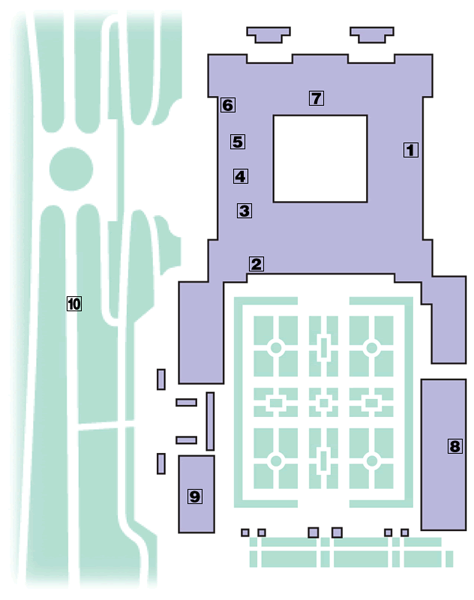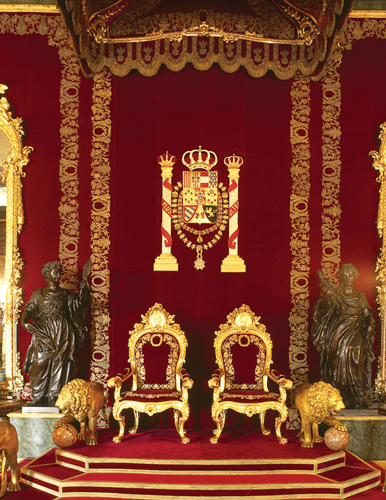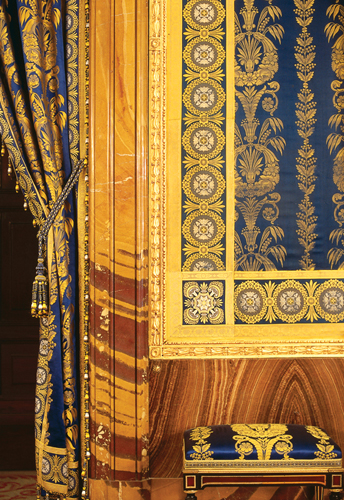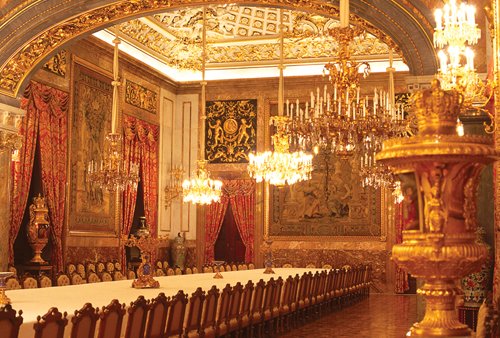Madrid’s fabulous Royal Palace, inspired by Bernini’s
designs for the Louvre in Paris, is one of Europe’s outstanding
architectural monuments. More than half of the state apartments are open
to the public, each sumptuously decorated with silk wall hangings,
frescoes and gilded stucco, and crammed with priceless objects d’art.
The palace’s setting is equally breathtaking. Laid out before the
visitor in the main courtyard (Plaza de Armas) is an uninterrupted vista
of park and woodland, stretching from the former royal hunting ground
of Casa de Campo to El Escorial and the majestic peaks of the Sierra de Guadarrama.
Plaza de Oriente
www.patrimonionacional.es
91 454 8800 Open
Apr–Sep: 9am– 6pm Mon–Sat, 9am– 3pm Sun; Oct–Mar: 9:30am–5pm Mon–Sat,
9am–2pm Sun; closed 1 & 6 Jan, 1 & 15 May, 12 Oct, 9 Nov, 24, 25
& 31 Dec Dis. access
|
|
The palace stands on the
site of the Alcázar, the 9th-century Muslim castle. In 1734 the wooden
structure burned down and Philip V commissioned Italian architect
Filippo Juvara then GB Sachetti to design a replacement. Work began in
1738 and was completed in 1764. The present king, however, prefers to
live at the Palacio de Zarzuela outside the city.
|

Plan of Palacio Real
|
Remember that the palace
can close for official ceremonies without prior warning, so check
opening times before you set out. The best time to avoid the queues is
early in the morning.
|
|
|
On the first Wednesday of the month (Oct–Jun) you can see the grand Changing of the Guard ceremony, which begins at noon.
|
|
Top 10 FeaturesFaçade Stand
for a few moments on Plaza de Oriente to enjoy the splendour of
Sacchetti’s façade, gleaming in the sun. Sacchetti achieved a rhythm by
alternating Ionic columns with Tuscan pilasters.

Façade
Main Staircase When
Napoleon first saw the staircase after installing his brother on the
Spanish throne, he said “Joseph, your lodgings will be better than
mine”, owing to Corrado Giaquinto’s fine frescoes. Hall of Columns This
exquisite room was once the setting for balls and banquets, and is
still used for ceremonial occasions. Attractions include Giaquinto’s
fresco of Charles III shown as the sun god Apollo and superb
17th-century silk tapestries. Throne Room This
room was designed for Charles III by Giovanni Battista Natale as a
glorification of the Spanish monarchy. The bronze lions guarding the
throne were made in Rome in 1651.

Gasparini Room Named
after its Italian creator, this dazzling room was Charles III’s robing
room. The lovely ceiling, encrusted with stuccoed fruit and flowers, is a
superb example of 18th-century chinoiserie.

Gala Dining Room The
banqueting hall was created for the wedding of Alfonso XII in 1879. The
tapestries and ceiling frescoes are by Anton Mengs and Antonio
Velázquez. Look out for the Chinese vases “of a thousand flowers”, in
the window recesses.

Royal Chapel Ventura
Rodríguez is usually credited with the decoration of this chapel,
although he worked hand-in-hand with other collaborators. The dome,
supported by massive columns of black marble, is illuminated with some
more of Giaquinto’s frescoes. Pharmacy The
royal pharmacy was created at the end of the 16th century to supply
herbal medicines to the court. Glass retorts, pestles, mortars and jars
fill the gilded shelves, while the reconstructed distillery shows how
they might have been used. Armoury The
royal armoury has been open to the public for more than 400 years. It
boasts more than 2,000 pieces, mostly made for jousts and tournaments
rather than the battlefield.

Campo del Moro These
beautiful gardens were landscaped in the 19th century and planted with
acacias, chestnuts, magnolias, cedars and palms. Stand on the avenue and
you’ll be rewarded with views of the palace’s façade.
|